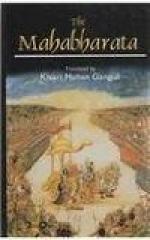122. Some editions read susaranab, meaning thou art he who well protects the universe.
123. The golden mail being the illusion of the Supreme Deity in consequence of which the universe has become displayed.
124. Thou art Pasupati; atodyah pratodanarhah pasavah yasya iti.
125. The commentator explains that Tarangavit, which is literally conversant with waves means one that is acquainted with the joys or pleasures that arise from the possession or enjoyment of worldly things, for such joys may truly be likened to waves which appear and disappear on the bosom of the sea or ocean of Eternity.
126. The commentator explains that the binder of Asura chiefs refers to the Supreme Deity’s form of Vishnu in which he had bound Vali, the chief of the Asuras. The plural form has reference to successive Kalpas.
127. The sense is that thou art he that is well conversant with the ritual of sacrifices.
128. Or, it may mean that thou art he that has no vestments, for no vestments can cover thy vast limbs.
129. Those that uphold others are, for example, the elephants that stand at the different points of the compass, the snake Sesha, etc. What is said here is that thou art the best of all these or all such beings.
130. The sense is that thou art Vishnu who is the foremost of the celestials and thou art Agni who is the lowest of the celestials; i.e., thou art all the celestials.
131. The body is as it were a pit into which the soul falls, determined by Desire and Ignorance.
132. Vasu, the commentator explains, indicates the Wind, for it means that which establishes all things into itself.
133. Nisachara is one acting through nisa, or Avidya, i.e., one who enjoys all objects, implying Jiva invested with Ignorance.
134. The Soul can view the Soul or itself, if it can transcend the body with the aid of Yoga.
135. The commentator explains that the first word means that thou art Hansa and that the second word means thou art Paramahansa.
136. Varhaspatya is a word that is applied to a priest. The deities first got their priest for assisting them at their sacrifices. Human beings then got theirs. Those born after Vrihaspati are Vrihaspatyas.
137. This word Nandivardhanah may also mean he that withdraws or takes away the joys previously conferred.
138. The language of the Veda is divine. That of the scriptures is human.
139. Literally, crown of the head.
140. i.e., that succeeds in effecting his Emancipation.
141. Mahanakha refers to the incarnation of Narasingha or the Man-lion assumed for slaying the Daitya Hiranyakasipu, the father of Prahlada. Maharoman has reference to the form of the mighty or vast Boar that the Supreme Deity assumed for raising the submerged Earth on his tusks.
142. Mahamuni may mean either one that is very mananasilah or one that is exceedingly taciturn.




